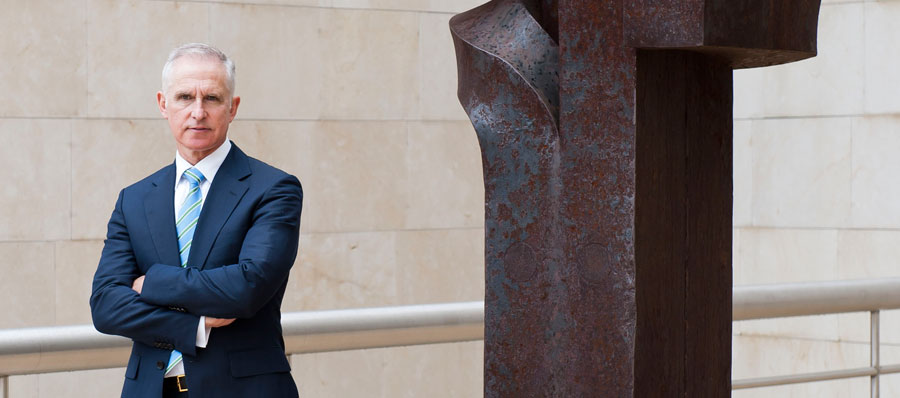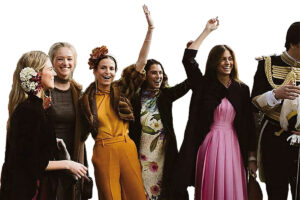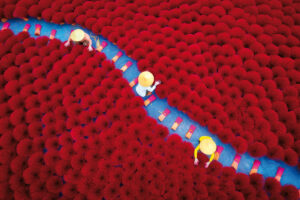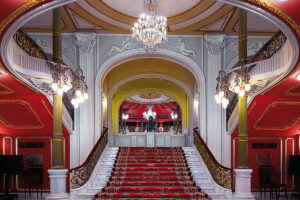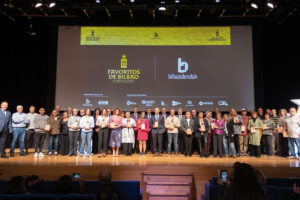A veces hace surf y le gusta Fra Angélico de Fiesole. Es Juan Ignacio Vidarte (Bilbao, 1956), un Doctor en Economía, post-graduado en el MIT, que tiene un trabajo fascinante: dirigir, nada más y nada menos, que el Museo Guggenheim Bilbao. Y a ello se aplica de forma cardioestimulante.
¿El proyecto, al que se le llegó a llamar exagerado (“…no hace falta tanta apoteosis para colgar cuadros.”) ha demostrado que estas apreciaciones han sido desmentidas por los hechos?
Por lo menos en la opinión de los que hemos considerado adecuado el proyecto, los resultados nos avalan. Esa decisión se tomó hace 21 años y ya ha cumplido 16 años de funcionamiento, no se si es apoteósico, pero sí una combinación donde cada elemento tiene su importancia; la arquitectura tiene su importancia, proporcionada al contenido y la escala, que es un elemento fundamental. Sin esa combinación todo el proyecto hubiera sido muy distinto.
¿Los economistas tienen su corazoncito para el arte?
¡Para el arte y para otras cosas! (risas). Mi relación con el proyecto hace 20 años venía desde mi convicción de que era un proyecto importante para la ciudad.
¿Fundamentalmente se buscaba un gestor?
Yo creo que sí. En la medida de que se tenga sensibilidad y conocimientos de los contenidos de tu trabajo, muy bien, ayuda mucho, pero también en este trabajo han de cumplirse objetivos, utilizar recursos limitados, establecer prioridades…
¿Es la costumbre de la Fundación Guggenheim?
Ha variado en el tiempo. La persona que dirigía la Fundación cuando yo me impliqué en el proyecto sí tenia un perfil de gestión. Actualmente el responsable, aparte de la gestión, tiene un peso específico mayor en otros campos como el curatorial. Cada proyecto -cada momento- necesita un perfil.
Chief Officer for Global Strategies: ¿Culo de mal asiento?
¡Ja, ja!. Bueno, un puesto así te da una visión importante de la situación y de las instituciones que están bajo el paraguas de la Fundación y este orden de cosas, para Bilbao es importante -a través de mi presencia allí- estar en la mesa donde se toman las decisiones. Por lo demás es cuestión de compaginar. Hablando de la Fundación Guggenheim a su página me remito para preguntarle acerca del proyecto Abu-Dabi. Es un gran proyecto. El museo se ubicará en una isla parcialmente artificial. Cuando se inaugure, la zona tendrá 150.000 residentes y además contará con un espacio cultural: Tres museos se están proyectando: el Louvre Abu-Dhabi donde tendrán presencia los museos públicos franceses abanderados por el Louvre, el Museo Nacional de los Emiratos Sheik Zayed que tiene una participación del British Museum y el Guggenheim el tercero. Será un museo de arte moderno y contemporáneo con un escenario cronológico desde finales de los 60 hasta nuestros días. Pero estamos buscando otro concepto de museo: algo transnacional. No una réplica de la visión occidental eurocéntrica o euroamericanocéntrica. Sino que se busca una perspectiva más multinacional, contemplando con especial atención a oriente medio y el norte de África así como un puente con Asia. Buscar diferentes perspectivas con sus puntos coincidentes o discrepantes.
Se me ocurre a mi que es como un camino iniciático cultural: Abu – Dabi – Venecia – Bilbao – Nueva York. Recordamos Juan Ignacio y yo los viajes del “Grand Tour” de los turistas del XVIII. ¿Jeff Koons o Fra Angelico?
Ja, ja… Bueno yo creo que lo bueno es que no hay que elegir; sino poder disfrutar de ambos. Como responsable de un museo cuya vocación es el arte moderno y contemporáneo la mayor parte de mi actividad se centra en esa época artística. Me gusta Beethoven y también los Beatles.
¿Crees que la presencia del Guggenheim ha sinergizado el mundo de los museos, incluso de las galerías en Bilbao?
Sí, indudablemente, sí. Sería imposible que no ocurriera. Traer a un millón de visitantes a un lugar donde viven más o menos medio millón de habitantes ha de producir impacto. Al Museo de Bellas Artes le ha venido muy bien y como institución ha aumentado su prestigio. Véase, por ejemplo, la ampliación que ha experimentado. En toda la zona cercana al museo es muy patente la presencia de galerías que se han articulado a través del Bilbao Art District, dándole una nueva personalidad a la zona. Todo esto quiere decir que la presencia del Museo ha puesto en valor todas esas actividades culturales.
De Bilbao de toda la vida. Aprovechando el título del libro de Jon Uriarte y Tomás Ondarra, ¿el Guggenheim Bilbao ya es como un caramelo de malvavisco?
Hombre, sí, yo creo que sí. El Guggenheim Bilbao es la imagen de Bilbao en el mundo. A lo mejor ha de pasar más tiempo para algunas personas (risas)… pero, para los menores de 20 años ya es “de toda la vida.”
Nuevas tecnologías y museística tradicional. ¿Liassons dangereuses?
Como en todo, pueden cometerse errores, sobre todo, cuando la tecnología se convierte en el protagonista y no en el medio. Es un aliado extraordinario, que no reemplazará la presencia física. Pero hace más accesible los contenidos, sin sustituirlos. Hubiera sido imposible haber llegado al colectivo de posibles visitantes en todo el mundo. Una vez dentro del museo, las nuevas tecnologías son muy importantes como ayuda a ciertos colectivos, para los programas de formación y para enriquecer la propia visita.
Cuéntame acerca de vuestra labor educativa. Vuestra labor didáctica.
La función educativa es la misión fundamental. El museo en si mismo es un espacio educativo. Como concepto, nuestra razón de ser es la educación. Nos gusta pensar en términos educativos, acercar la cultura a los ciudadanos. Tenemos unos 40-45 programas que se desarrollan todos los años, de los cuales algunos requieren una presencia, los hay para escolares y para educadores, siempre en colaboración con los departamentos educativos. Recibimos entre cien mil y ciento cincuenta mil visitantes que son educadores y estudiantes. Y, esto es importante, la quinta parte de esa cifra son franceses, por tanto la visita a Bilbao ya forma parte del currículo educativo francés. Tenemos programas para ver en la red, para gente que no viene al museo, para colectivos específicos…
¿Que hobbies tiene el Director del Guggenheim?
Muy sencillos, leer, el cine, la música, pasear, subir al monte, la playa en verano… Cada vez menos, el surf. Y desde luego estar con la familia.
Y pienso yo que el hobby principal de este surfista extemporáneo de aspecto anglosajón es el museo. El caso es que me lo figuro con camisa fruncida y una paleta repleta de tierra de siena tostada, azul de cobalto y rojo cadmio… Pensaba que a lo mejor te habías aficionado a la acuarela a “plein air”.
¡No, no tengo dotes para eso! Admiro muchísimo a la gente que tiene esa capacidad y me gusta disfrutarlo pero no tengo esa pulsión.
Cifra de visitas para este año. Al 31 de Diciembre.
Creo que llegaremos al millón de visitantes. Seguimos las previsiones. El año pasado, es verdad que tuvimos un verano extraordinario, pero este año estaremos dentro de lo previsto y dos de cada tres serán extranjeros.
No tengo más remedio de lamentar que esa cifra no sea al menos equilibrada y naturalmente le pregunto al Director, el porqué de ésta desproporción.
No lo se. El Guggenheim Bilbao es una referencia internacional. En cualquier caso, el número de visitantes del resto del Estado sigue siendo muy importante.
En la galaxia Guggenheim, ¿qué ha aportado Bilbao que le hace distintivo?
Cada museo para cumplir su papel ha de desarrollar una entidad propia. Una identidad especifica. En el caso del Guggenheim Bilbao la arquitectura es determinante. Y esa arquitectura crea un espacio expositivo diferente. La colección que ofrecemos, muy centrada en la segunda mitad del siglo XX, también le da un carácter distintivo al Guggenheim Bilbao. El museo ha tenido una relación con su entorno muy particular, con lo que como elemento referencial es muy importante. El papel del museo ha sido un catalizador, ha dado lugar al “efecto Guggenheim”. El futuro Museo de Abu-Dabi, está inspirado en el de Bilbao.
Quiero que el Director del museo formule un deseo.
No vamos a ser muy ambiciosos. El museo tiene 16 años. Mi deseo es que dentro de otros 16 años siga siendo tan vivo, tan importante y tan relevante para la ciudad y para el mundo del arte.
Charlamos de la arquitectura rompedora, de la espiral enloquecida para su época del Guggenheim de Nueva York y de la intimista casa de Peggy, en Venecia. Y llegamos a varias conclusiones… Hoy el sol tornasola con especial énfasis las capas de titanio… Yo prefiero el de Bilbao. Es hora de dejar trabajar al tripulante de la nave, una de las que circula airosamente en la constelación Guggenheim. Amable, correctísimo y sabio. Hay una exposición temporal de Tàpies escultor. La charla con Vidarte y este evento artístico redondean una mañana fantástica.
Heartfelt Management
He occasionally surfs and likes the art of Fra Angelico of Fiesole. Meet Juan Ignacio Vidarte (Bilbao, 1956), a doctor of economics, an MIT postgraduate with a very exciting job: Managing none other than the Guggenheim Museum Bilbao. And he takes his role to heart.
Has this project, which was at one point considered over the top (“…there´s no need for all this fuss to hang some paintings”) already proved the critics wrong?
That’s certainly the view of those of us who were behind the project from the start, and the results show we were right. This was a decision that was taken some 21 years ago, and now the museum has recently celebrated its 16th anniversary. I´m not sure it was over the top but the combination of each element is important; the architecture, in proportion to the content and scale. Without that combination, the project would have been very different.
Do economists have a taste for art?
For art and for other things! (Laughs). My involvement in the project 20 years ago was as a result of my conviction that this was a very important project for the city.
Basically, there was a need for a manager?
I believe so. Of course being familiar with the subject you work with is a great help, but it’s still important that you can meet objectives, use limited resources appropriately, and establish priorities…
Is that the custom within the Salomon R. Guggenheim Foundation?
That’s something that’s changed over time. The person in charge of the Foundation when I first got involved came from a management background. The current leader, aside from management experience, also has a strong background in other areas of expertise, such as curating. Each project, at different stages, needs people with different profiles.
Chief Officer for Global Strategies: Do you have itchy feet?
Ha ha! Well, a role such as this gives you an interesting perspective of the current situation and of the institutions under the Foundation´s umbrella. It´s important for Bilbao, through my presence, to have a seat at the decision making table. The rest is just a question of finding the right balance between the two.
Speaking about the Guggenheim Foundation, I would like to ask you about the Abu-Dhabi project.
It’s a fascinating project. The museum will be located on a partially artificial island. Once it is open, the area will have 150.000 residents and will house a unique cultural space: There are three museums currently involved in the project: The Louvre Abu-Dhabi, which will be a showcase for the French public museums led by the Louvre; the Sheik Zayed Emirates National Museum in participation with the British Museum, and the Guggenheim. The Guggenheim will be a modern and contemporary art museum that will incorporate artworks from the 60’s to today. But, moreover, we are looking for a different museum concept: something transnational. not a replica of the Eurocentric or western styles, but we´re looking for more transnational perspectives, paying special consideration to the Middle East and North Africa as a bridge with Asia. We are looking for different perspectives, with things in common and differences.
It occurs to me that it’s almost like a cultural rite of passage: Abu-Dhabi – Venice – Bilbao – New York. It reminds Juan Ignacio and I about the “Grand Tour” voyages of the tourists of the 18th century. Jeff Koons or Fra Angelico?
Ha, ha… Well, I think it is best not to have to choose, but being able to enjoy both. As the man in charge of a museum dedicated to modern and contemporary art, most of my job relates to that artistic age. That being said, I like Beethoven and also the Beatles.
Do you believe the presence of the Guggenheim has brought synergy to the art world including art galeries in Bilbao?
Yes, without a doubt. It would have been impossible for it not to happen. Attracting a million visitors to a region home to around a million inhabitants has to produce that effect. It has been very beneficial for the Bilbao Fine Arts Museum, as it has enhanced its prestige as institution, as proven by its recent significant expansion. Around the museum, it is evident that the presence of art galleries, throughout the Bilbao Art District, has provided new character to the neighbourhood. This shows the role the museum has had in all these cultural activities.
From Bilbao as ever. Taking advantage of the title of the book by Jon Uriarte and Tomás Ondarroa, is the Guggenheim Bilbao now as famous as the typical local marshmallow sweet (the caramelo de malvavisco)?
Well, yes I think so. The Guggenheim Bilbao is now the image of Bilbao within the world. Although, it may still take some time for some people to get used to it (Laughs)… But, for those under 20 it has always been there.
New technologies and traditional museum studies. Friends or foes?
As with everything, mistakes can be made, particularly when technology takes center stage. It’s an exceptional ally, but cannot replace physical presence. It makes content more accessible, but without replacing it. It would be impossible to reach all potential worldwide visitors without it. Once inside the museum, new technologies are vital in order to give assistance to some people, as part of training programs and to enhance the visit.
Tell me about the educational mission of the museum.
The importance of educational work is fundamental to us. The museum itself is a learning space. As a concept, our purpose is that of education. We like to think in educational terms, bringing culture and citizens closer together. We provide between 40 and 45 educational programs every year, some of which require a visit; there are programs for students as well as for teachers, always in collaboration with the educational departments. We welcome between 100 and 150 thousand visits from educators and students. And, more importantly, a fifth of the participants are from France, so a visit to Bilbao is already part of the French curriculum. We also have programs that allow people to visit online, for those that can´t visit the museum, and for groups with specific needs…
What hobbies does the director of the Guggenheim have?
Very simple ones, reading, cinema, music, walking, mountain hiking, going to the beach in the summer… and surfing, although less frequently now. And of course spending time with the family.
And I feel the main hobby of this almost British-looking, old-style gentleman and occasional surfer, is the museum. I can picture him with a pleated shirt, and a paint pallet of sienna, cobalt blue and cadmium red… I thought perhaps you would have become fond of watercolor painting outdoors?
No, I don’t have the skills for that! I really admire the people who can do that and I really do enjoy it myself but lack the urge to actually go out and do it.
As of the 31st of December, how many visitors do you expect for this year?
I believe we will reach a million visitors. We are on track to meet the forecasted figures. Last year, it is true we had an exceptional summer, and this year we are within the expectations, also 2 out of every 3 visitors will be international.
I can´t help but feel sorry the figures aren’t more balanced and I have to ask the director as to why there is such a difference.
I don´t know. The Guggenheim Bilbao is an internationally renowned institution.In any case, the number of national visitors is still a substantial figure.
Within the Guggenheim galaxy, what makes Bilbao so distinctive?
Every museum must develop its own identity, an individual identity. In the case of the Guggenheim Bilbao, the architecture is a stand out feature. It creates a different exhibition space. The collection we showcase is centred on the second half of the 20th century, which also provides the Bilbao Guggenheim with character. The museum has had a unique relationship with its surroundings, so as a point of reference it is very important. The role of the museum has been that of a catalyst, giving rise to the Guggenheim Bilbao effect. The future Museum in Abu-Dhabi will be inspired by the one in Bilbao.
I would like the director of the museum to make a wish.
I don’t want to be too ambitious. The museum has been around for 16 years. My wish is that 16 years from now, it is still as alive, as important and as relevant for the city of Bilbao and also the world of art as it is today.
We talk about groundbreaking architecture, from the frenzied spiral at the New York Guggenheim, to Peggy´s intimate house in Venice. And we reach some conclusions. Today, as the sun shines and the light bounces off the titanium scales, I like the Guggenheim Bilbao best. It´s now time to allow this captain to get back to work on his ship, one of the many that sail freely within the Guggenheim constellation. Kind, polite and wise. There’s a seasonal exhibition about the sculptor Tàpies. The talk with Vidarte and this artistic event round off a fantastic morning.
Texto: Antonio Terán
Imágenes: Fundación del Museo Guggenheim Bilbao
[gmedia id=37]

